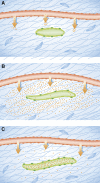Lymphatics thrive on stress: mechanical force in lymphatic development
- PMID: 22334045
- PMCID: PMC3280563
- DOI: 10.1038/emboj.2011.484
Lymphatics thrive on stress: mechanical force in lymphatic development
Abstract
EMBO J 31 4, 788–804 (2012); published online December 13 2011
The arteries, veins, capillaries and lymphatic vessels that comprise the vertebrate vascular system function to transport blood and lymphatic fluid to and from the tissues. It is therefore unsurprising that development, maintenance and physiology of these structures are strongly influenced by mechanical forces such as pressure and fluid shear stress associated with fluid flow (Hahn and Schwartz, 2008; Culver and Dickinson, 2010). Both embryonic morphogenesis and adult homeostasis of blood vessels appear to be organized so that vessel dimensions are matched to tissue demand. The accompanying paper from Planas-Paz et al (2011) elegantly demonstrates that a similar principle operates for lymphatic development as well.
Conflict of interest statement
The authors declare that they have no conflict of interest.
Figures
Comment on
-
Mechanoinduction of lymph vessel expansion.EMBO J. 2012 Feb 15;31(4):788-804. doi: 10.1038/emboj.2011.456. Epub 2011 Dec 13. EMBO J. 2012. PMID: 22157817 Free PMC article.
References
-
- Larrivee B, Freitas C, Suchting S, Brunet I, Eichmann A (2009) Guidance of vascular development: lessons from the nervous system. Circ Res 104: 428–441 - PubMed
Publication types
MeSH terms
Grants and funding
LinkOut - more resources
Full Text Sources
Other Literature Sources


